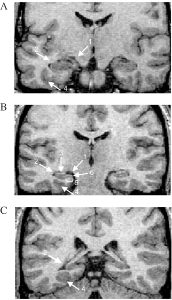Abstract
The purpose of this study was to evaluate systematically shape and positioning of the hippocampal formation (HF) in patients with partial epilepsy related to malformations of cortical development (MCD) and those with temporal lobe epilepsy (TLE). We studied 76 patients with MCD, including focal cortical dysplasia (n = 29; lesions located outside the temporal lobe in all), heterotopia (lesions outside of the temporal lobe, n = 14; lesions extending into the temporal lobe, n = 16), polymicrogyria (bilateral perisylvian, n = 14; unilateral perisylvian, n = 3) and 30 patients with TLE (hippocampal atrophy, n = 15; normal hippocampal volumes, n = 15). Shape and positioning of the HF were evaluated using a set of eight predefined morphological characteristics. In addition, the degree of hippocampal vertical orientation and medial positioning were assessed quantitatively. Patients were compared with 50 healthy controls. At least three criteria describing abnormal HF shape and positioning were found in 5/50 (10%) healthy controls, 37/76 (49%) MCD and 13/30 (43%) TLE patients. An association with all criteria was found in MCD and TLE, but not in healthy controls. In MCD there was no association between the side of HF shape abnormalities and the side of the cortical malformation or the EEG focus. Likewise, in TLE, HF abnormalities were not related to the side of the EEG focus. In both MCD and TLE patients who had hippocampal atrophy, no association was found between the side of HF shape abnormalities and the side of atrophy. Abnormal HF shape and positioning are found in a similar proportion in MCD and TLE. In TLE, they may be a marker of a more extensive disorder of brain development and may participate in the development of this condition.

